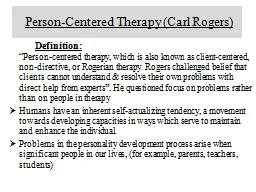

Definition Personcentered therapy which is also known as clientcentered nondirective or Rogerian therapy Rogers challenged belief that clients cannot understand amp resolve their own problems with direct help from experts ID: 779500
Download The PPT/PDF document "Person-Centered Therapy (Carl Rogers)" is the property of its rightful owner. Permission is granted to download and print the materials on this web site for personal, non-commercial use only, and to display it on your personal computer provided you do not modify the materials and that you retain all copyright notices contained in the materials. By downloading content from our website, you accept the terms of this agreement.
Slide1
Person-Centered Therapy (Carl Rogers)
Definition:
“Person-centered therapy, which is also known as client-centered, non-directive, or Rogerian therapy. Rogers challenged belief that clients cannot understand & resolve their own problems with direct help from experts
”.
He questioned focus on problems rather than on people in therapy
Humans have an inherent self-actualizing tendency, a movement towards developing capacities in ways which serve to maintain and enhance the individual.
Problems in the personality development process arise when significant people in our lives, (for example, parents, teachers, students)
Slide2Role of the Counsellor
The counsellor sets up and facilitates a climate in which the client is free and encouraged to explore all.
Focus is on the client‐counsellor relationship.
The therapist is aware of the client’s verbal and nonverbal behaviour and reflects that back to them.
The counsellor trusts the client to develop an agenda on which he or she wishes to work.
He argued that we have an innate drive to reach an optimal sense of ourselves & satisfaction with our lives.
He felt that the process by which we do this, not the end result is what matters.
Person-centered counselor is to take periodic oral quizzes on how much they are learning and understanding.
Slide3Cognitive behavioral therapy (CBT) Cognitive-Behavioral
Theory is the concept that cognition plays an important role in behavior change.
Cognitive-behavioral intervention is a combination of cognitive therapy (examining the things you think) and behavioral strategies (examining the things you do) to
solve a variety of behavioral and psychological problems.
CBT is a type of talking treatment that focuses on how your thoughts, beliefs and attitudes affect your feelings and behavior. These thoughts, feelings, and actions all interact and influence each other. The best way to understand this is to think about them as a triangle:
Slide4Role of Counselor and Counselee in Cognitive Behavioral Therapy The
therapist's role is to listen, teach, and encourage, while the client's role is to express concerns, learn, and implement that learning. Therefore, CBT therapists do not tell their clients what to do, rather, they search for client strengths and use them to teach their clients how to do. The educational emphasis of CBT has an additional benefit; it leads to long term results. When people understand how and why they are doing well, they know what to do to continue doing well. CBT therapists believe it is not a person's circumstance or situation (necessarily) that is having a negative impact on his or her life, but rather the way in which the individual perceives and responds to the situation.
Slide5Reality TherapyReality Therapy (also called Choice Theory) was created by William Glasser in 1965, MD. The emphasis of this program is to help students connect behavior with consequence. This is done with class meetings, clear rules, and contracts.
The Reality Therapy approach to counseling and problem-solving focuses on the here-and-now of the client and how to create a better future, instead of concentrating at length on the past.
it emphasizes making decisions, and taking action and control of one's own life.
Reality Therapy is a considered a cognitive-behavioral approach to therapy; that is, it focuses on facilitating the client to become aware of, and if necessary, change, his/her thoughts and actions.
This also includes Positive Approach to Discipline (PAD), which is based on Reality Therapy. Reality Therapy is used a lot in counseling.
Slide6Role of the Therapist in Reality TherapyTo create a connection between people, the reality therapy counselor, teacher or manager will
Focus on guiding a person's attention away from past behaviors in order to focus on those that occur in the present.
able to improve external relationships and experience a more fulfilling l
ife
focus on what counselees can do directly - act and think
Avoid criticizing, blaming and/or complainingRemain non-judgmental and non-coercive make specific, workable plans Be patient and supportive
Slide7Slide8The Counseling Process
The Client-Counseling Relationship: Collaborative, egalitarian, respectful and cooperative.
Understanding the Client: How is the client behaving? What does the client gain from this behavior? Why does the client do this in this manner?
Assessment and Analysis: Family Atmosphere and Constellation, Birth Order, Early Recollections, Dreams, and Priorities
Slide9Strategies for Helping Clients
Restatement: Restating the client’s words to form clarity and convey understanding.
Reflection: Restating the client’s words to give deeper meaning regarding the underlying feeling.
Guesses, Hunches, Hypotheses: Making statements to explain what is happening.
Questioning: To get a better understanding but also reframe the symptoms for the client.